New perk! Get after it with local recommendations just for you. Discover nearby events, routes out your door, and hidden gems when you sign up for the Local Running Drop.
On August 25, 2007, 20 miles south of Red’s Meadow, and about 80 miles shy of a speed record on California’s John Muir Trail (JMT), Sue Johnston hit a wall. It wasn’t exhaustion or injury that was stopping her, though. The obstacle was dressed in green and nearly impenetrable.
“I was in the middle of nowhere, with a little Nathan pack on. This Forest Service ranger accosts me and says, ‘Where are you going?! Where’s your permit?’” Johnston says.
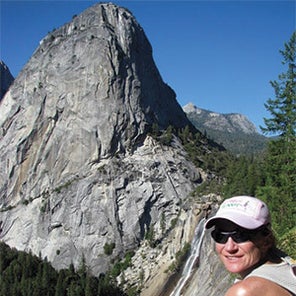
She whipped out her permit.
“I was laughing. I said, ‘I started the trail two days ago. I think I’m going to make Red’s Meadow, barring tripping or breaking my leg.’”
Eventually, the ranger relented and Johnston rolled on, arriving at the JMT’s northern terminus in Yosemite Valley in a time of 3 days 20 hours. It was an overall record time for the 221-mile trail.
Two years later, LA-based ultrarunner Brett Maune bested Johnston’s time by six hours, though her record still stands as the fastest women’s time despite efforts by some of the country’s best female trail runners, including Amber Monforte, 38, former Tahoe Rim Trail women’s FKT holder, and Jenn Shelton, 33, who rose to fame as one of the personalities in Christopher McDougall’s Born to Run.
In the trail-running community, however, Johnston’s record is called by a different name: a Fastest Known Time, or “FKT.” FKTs can range from travelling the classic long trails like the JMT or Appalachian Trail, to sprinting up local highpoints like Boulder’s Bear Mountain or Alaska’s Mount Marathon.
First FKT
In 1998, Boulder, Colorado, residents Peter Bakwin, now 54 and a retired physicist with the National Oceanic & Atmospheric Administration, and Buzz Burrell, now 65 and brand vice president at Ultimate Direction, tackled a speed attempt on the 500-mile-long Colorado Trail—the first of what would be many adventures together.
In photos from the period, Burrell looks solid, less lithe ultrarunner and more the kind of guy you’d willingly follow into battle. Bakwin appears young and playful. During a moment captured on that 1998 trip on the Colorado Trail, Bakwin’s arms are outstretched in a field of flowers, with an, “Aren’t we lucky?” smile on his face. Burrell, peering over his partner’s shoulder from a distance, looks to be gearing up for battle. Ironically, it was Bakwin who got injured. He dropped after 330 miles. Burrell, however, finished in what they considered a record time of 11 days 16 hours 13 minutes.
The following summer, they began eyeing a record on the JMT. It was a project that required research. However, in those early days of the Internet, information was vague. Even previous speed-record holders had conflicting accounts. Blake Wood’s 1998 article in Ultrarunning recounted his fast time on the JMT of just under five days. But there were gaps—big ones—in the records, including a vast blank spot from a 1948 attempt to the early 1980s.
Burrell and Bakwin faced a conundrum. It was a pretty safe bet that Wood’s time was the fastest ever. But it wasn’t a certainty. So, Burrell started describing Wood’s effort as the “fastest-known time.”
“We needed a term that paid homage to the people who came before,” Burrell says. “We didn’t know what the fastest time was, and so the term was born. By saying ‘fastest-known time,’ you’re leaving the door open for some great athlete who was off the radar and did it in the pre-Internet era.”
Bakwin and Burrell Set a Goal
One of the world’s great long-distance trails, the John Muir Trail wends its way 221 miles through California’s High Sierras without crossing a road. In many places, trailheads are a day away. Mount Whitney, the high point of the lower 48, is the southern terminus. To the north, the trail ends at the crown jewel of the National Park system: Yosemite Valley.
Bakwin and Burrell set themselves a goal of four days. It would be a new fastest-known time. For a year, they planned methodically. They dehydrated food, researched support locations and retrofitted their gear.
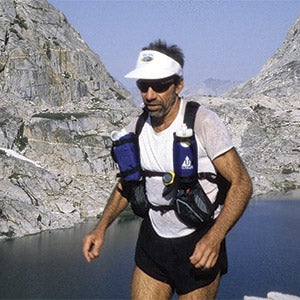
Burrell sewed bottle holsters to the front of his trail-running vest—a design that Ultimate Direction would later adopt.
They set off from Whitney Portal on July 31, 1999. For three days, everything went as planned. Then, just 23 miles from the end of the trail, a fierce hailstorm pounded the duo, forcing them off trail at Tuolumne Meadows.
“We were on target,” says Bakwin. “And then it was like, ‘Oh, well, I guess we’re done.’”
Well, not quite. After a night off, they returned and finished the JMT, pulling into Yosemite Valley in 4 days 9 hours, just off their target, but still good enough for a record—or, more accurately, the Fastest-Known Time.
It was a turning point. Burrell published an article in this magazine in 2001. In the story he wrote, “We did what we had come to do—share an incredible experience, push our limits into unknown territory and traverse one of the world’s great trails.”
Burrell is quick to point out, however, that they were anything but pioneers. “What we did was put multi-day trail running on the map,” he says. “We weren’t really good athletes, but we were at the right place at the right time. We were the spark plug. We showed that this could be fun and cool.”
Inspired by the JMT experience, Bakwin expanded his research and added more findings to a corner of his personal website, asking for others to share information. At first, he focused on the fastest-known times for long-distance trails: The John Muir Trail, the Appalachian Trail, the Grand Canyon rim-to-rim-to-rim and Vermont’s Long Trail. Updates came from around the country. Wanting more collaboration, Bakwin launched a discussion forum at the humble, unwieldy address of fastestknowntime.proboards.com.
“I experience what I would call transcendence,” Bakwin says. “You run and run and run until you fall down, and you’re either done, or some kind of miracle occurs and all of a sudden you feel good. I want the website to be a place where people can share these stories.”
Burrell’s article and Bakwin’s website were catalysts for the FKT movement. All of a sudden, multi-day trail FKTs were on the map, and trail running would never be quite the same.
People Do What Moves Them
Burrell’s article and Bakwin’s website, serendipitous as they were, could not have been timed better if they had been produced by ad-agency execs pouring over reams of marketing research.
GPS watches were just coming into vogue, and Strava was not far behind. Within a decade, both would be nearly ubiquitous, allowing runners around the world to lay down their own FKTs, challenging neighbors and visiting runners alike.
Culturally, trail running was shifting, too. Between 2000 and 2010, the number of participants in trail-running events more than doubled. Professional race organizers became more commonplace, and lotteries were instituted for popular events.
“You show up at a race, you just put on your shoes, grab a water bottle and go,” says Bakwin. “There are aid stations, you follow the markers and you keep going until someone tells you you’re done.” For many trail runners, the organic, brand-free structure of the FKT became a welcome respite.
FKTs also have one particular advantage over trail races: they can take place on routes where large events would never be allowed by public-land managers. Says Rickey Gates, who has held multiple FKTs on routes such as Yosemite’s Half Dome, Colorado’s Four Pass Loop and California’s Mount Shasta. “They’re on courses where you’re never going to have a traditional race for reasons of danger, logistics, legalities or all three.”
“With FKTs, there are no ambassadors or spokespeople,” Burrell says. “People can do what moves them.”
Heather Anderson is one such example. Using the trail name Anish, the 35-year old Seattle-based personal trainer and public speaker has ticked off FKTs on the 2,650-mile long Pacific Crest Trail, the 2,190-mile Appalachian Trail and, this past November, the 800-mile Arizona Trail. Were it not for the need to document her trip to meet FKT community guidelines, Anderson might be entirely unknown.
“I do more social media than I would like to, simply because it’s an important part of documenting the FKT,” she says. “But I don’t like to make a big deal about it. I try to find that compromise between documentation, authenticity and staying true to myself and what I want from the experience.”
However the FKT community is not without shared understandings. Burrell sums up the FKT philosophy: “Own what you did. Let everyone else make up their minds about what it means.”
That sounds simple, but in practice it can get tricky. The difference between a supported, self-supported and unsupported FKT can get confounding. On California’s popular Tahoe Rim Trail, for example, some runners make use of tap water available at campgrounds along the relatively dry route. Are those FKTs unsupported? Right now, the consensus is: no.
“If someone makes a judgement and says you received support, and your FKT doesn’t really count as an unsupported effort, fine,” says Burrell. “Let that person make that judgment. That’s what makes the FKT community strong. Not its singularity, but its multitudes.”
The Kilian Effect
As summer 2009 approached, a 21-year-old trail runner from Sabadell in Catalonia, Spain, had his eye on an FKT on a long-distance trail in the United States.
Kilian Jornet had good reason to think he could tick one off, too—the year before, he had won the prestigious Ultra-Trail du Mont-Blanc and was named champion of that year’s Skyrunning World Series. Jornet wanted to run trails in the United States, and was trying to decide between the John Muir Trail, Grand Canyon rim-to-rim-to-rim and California’s Tahoe Rim Trail.
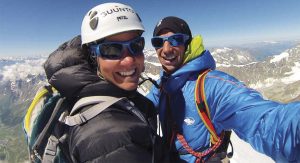
“That was the first time I heard the term FKT,” he says. “[In Europe] we used ‘record’ for mountain speed climbs like the north faces of the Alps, and the Matterhorn, and also for long-distance trails such as the Corsica trail and the GR5. [FKT] makes more sense than a ‘record,’ since it’s possible someone has run faster and not published or told it to somebody.”
Jornet decided on pursuing the John Muir Trail FKT but was denied a permit by the National Park Service. Says Bakwin, “They marched in there and announced they wanted to do a speed record on the JMT, and the rangers looked at him and said, ‘No, we don’t support that.’”
Instead, the team turned their attention to the 165-mile Tahoe Rim Trail, where Jornet quickly established an FKT of 38 hours 32 minutes.
Jornet would later go on to own a dizzying array of FKTs like the Grand Teton and Mt. Kilimanjaro.
“Kilian is the best mountain runner in the world. So, when he started doing FKTs, there was instant cred,” says Burrell. “Once he picked up the term ‘FKT,’ everyone picked it up, and the term went all over the world.”
Summits of My Life
Jornet continued winning races and ticking off FKTs, notably setting a speed record on Greece’s Mount Olympus on June 10, 2011, and then winning Western States 100 two weeks later. In 2012, he launched “Summits of My Life,” challenging himself to set new FKTs on summits around the world. First to go was Mont Blanc, from the Chamonix valley where he lived at the time.
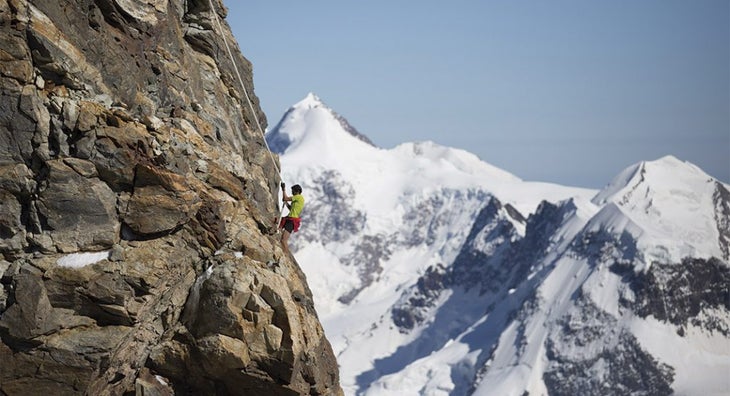
Then, on August 21, 2013 Jornet blazed up to the summit of the Matterhorn from the church steps in Cervinia, Italy, and back down in 2 hours 52 minutes, shattering Bruno Brunod’s longstanding record by more than 20 minutes.
Today, all that’s left for the Summits of My Life are Russia’s Mount Elbrus and Mount Everest. So far, Jornet has been twice rebuffed on Everest, first by the earthquake that struck Nepal in April 2015, and later by snowstorms and high avalanche risk during September 2016.
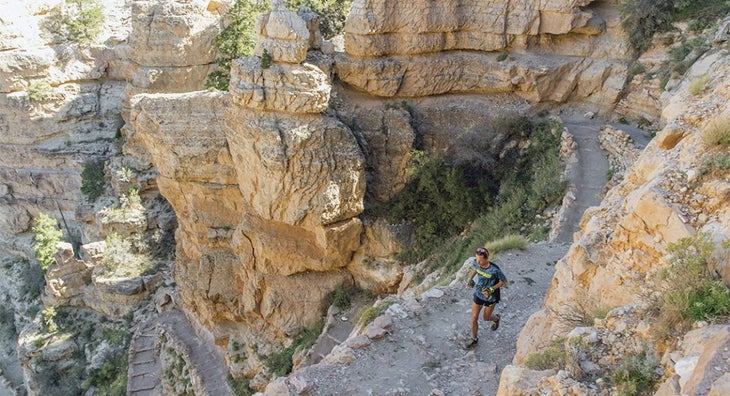
Jornet appreciates what FKTs add to trail running. “A race is great because you can push yourself against other strong runners. In a race, though, competitors have the same rules,” he says. “In an FKT, every person can make decisions: assisted or not? If so, how much? Pacers or not? It’s also a decision of logistics and experience that each runner gets to feel.”
With Jornet’s FKTs capturing both headlines and the public imagination, it wasn’t long before other trail runners followed suit.
FKT Evolution
In 2015, Scott Jurek, 43, set a new FKT on the Appalachian Trail, while millions followed his journey on social media. Says Bakwin, “I think he just promoted the hell out of it. He’s good at that. Plus, he has a shit ton of followers on social media.”
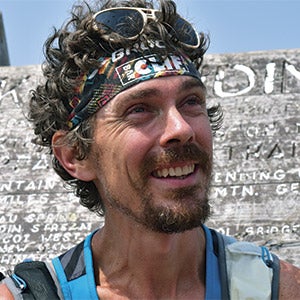
“The New York Times called and sent a photographer to my house!” adds Bakwin. On Bakwin’s FKT proboards website, the discussion about FKTs on the Appalachian Trail received 55,000 views—nearly 10 times the usual numbers.
In 2016, Utah ultrarunning legend Karl Meltzer, 48, bested Jurek’s time on the AT by nearly 10 hours. “It’s about being able to persevere,” Meltzer says. “You need to mentally prepare. On an FKT like the AT, bad patches happen every day. It’s a mind-boggler. I think I was in search of a project that would raise the bar for me.”
After two failed attempts in 2008 and 2014, Meltzer planned his third (ultimately successful) effort meticulously, and factored in plenty of support. “There’s strategy, crew, logistics and planning,” he says. All of this means one other thing: cash. According to Meltzer, his sponsors chipped in nearly $100,000 to cover the cost of the project.
Growing Pains
On the same Sunday in 2016 that Meltzer topped Jurek’s AT record, a woman by the name of Kaiha Bertollini claimed to have bested him by 16 hours.
Bertollini was a blank slate, unknown to anyone in the FKT community. A lively discussion flourished.

Bertollini’s evidence was scant. There were other red flags, too: a driver came forward and confirmed that he had given Bertollini a ride around one section of the trail. What’s more, while Bertollini claimed a self-supported FKT, she had a friend closely following the trip and aiding in a related fundraising effort.
“Did she cheat? I don’t know,” says Bakwin. “But her case certainly pushes the boundaries of credulity.”
In the early days of the FKT, everyone knew everyone else. As the numbers grow, though, new names appear, not all of them known to Bakwin or the FKT regulars. One result is that FKT claims now need stronger substantiation.
Policing can be hit or miss. “Typically, someone will send me an email, saying, ‘I don’t believe this claim,’” says Bakwin. “Then it’s kind of up to me. What I do next depends on the situation.”
Bakwin points out that there’s yet to be a case of cheating that’s been proven. Dubiously fast claims that have been withdrawn after scrutiny? Sure. Bakwin now recommends anyone attempting a new FKT to use a GPS beacon, which transmits data every 10 minutes to a website. Unless you’re tossing it from runner to runner, cheating becomes nearly impossible.
The role of investigating uncertain claims isn’t one Bakwin imagined for himself. “I think if this [sponsorships and media attention] continues to Bakwin. “Like the Matterhorn. It’s not just a trail-running record.”
Last spring, a team of ultrarunners and ski-mountaineering racers ticked off the iconic Hardrock 100 route on skis. Two years ago, the late climber and BASE jumper Dean Potter set the new FKT on a Yosemite Valley loop that included solo climbing Half Dome, then running back to the trailhead.
Meanwhile, Bakwin’s FKT pro boards cruise along. “Red Bull hasn’t purchased the FKT,” says Gates. “I hope it remains this organic, amorphous group. It’s amazing that our lead source and prime documentation of the FKT is in a format from 1995. But, it’s all you need.”
Bakwin’s FKT site holds stories from around the world. In the United Kingdom, it’s fell running. In New Zealand, there are new FKTs on the “tracks,” or multi-day hiking routes. In South Africa, elite trail runner Ryan Sandes has been busy laying down FKTs on Capetown’s popular Table Mountain and on the Drakensburg Grand Traverse, a 125-mile route with no designated trail.
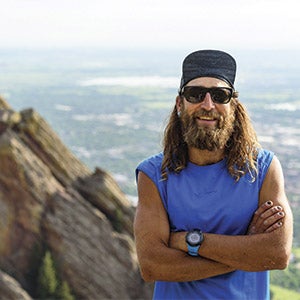
Here in the U.S., a new generation of trail runners in Boulder, Colorado, are challenging the FKTs set by trail runner Anton Krupicka on the Flatirons, which include sections of technical rock climbing and rappel descents.
And aside from more technical routes and the big-name trails, there are dozens of regional FKTs of note, too: Arkansas’ 165-mile Ozark Highlands Trail, New Hampshire’s Presidential Range traverse and highpoints like Washington’s Mount Rainier, Montana’s Granite Peak, Utah’s Kings Peak and California’s 14,505-foot Mount Whitney.
The FKT Project
With no formal organization, trophies or gold-embossed certificates to frame and hang, it’s poetic that Gates, one of trail running’s most carefree personalities, has stepped in to contribute.
As he roamed the country on his motorcycle ticking off FKTs of his own, Gates started collecting unique belt buckles—one each for what he considered some of the top FKTs in the West, including The Grand Canyon rim-to-rim-to-rim, Half Dome and the Grand Teton. Together with artist and woodworker Elizabeth Thorp, he’s quietly launched the FKT Project.
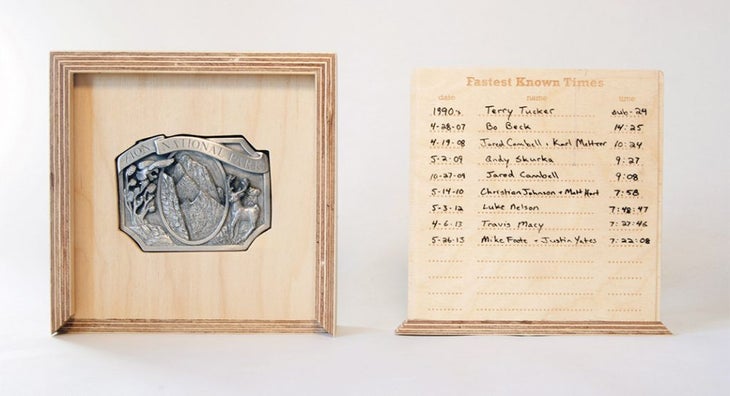
The idea is simple: each framed buckle passes from one FKT holder to the next, with the signature and date added with each faster time. “It’s personally driven,” says Gates. “These are all FKTs that I thought that I could get, or that I did get.”
Since launching the effort, Gates has added women’s FKTs to the list. He’s also hoping to expand the FKT’s to include Eastern routes, such as the Pemi Loop in New Hampshire’s White Mountains.
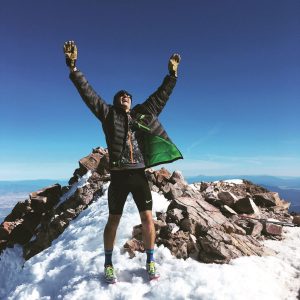
Now, four years after Gates launched the FKT project, the buckles are all out of his possession. “It was cool to pass on that last [buckle],” says Gates, who’s FKT on California’s Mount Shasta was bested last summer by Ryan Ghelfi.
Gates’ buckles are still on the move. Last summer, former Grand Canyon rim-to-rim-to-rim FKT holder Rob Krar passed his buckle to Jim Walmsley, 27, from Flagstaff, Arizona, who bested Krar’s time by 26 minutes, finishing in 5 hours 55 minutes 20 seconds.
“Rickey’s buckle project will undoubtedly hold different meaning to each of us fortunate enough to possess one,” says Krar, 40, also from Flagstaff. “My six hours and 23 minutes below the rim was one of the most rewarding experiences of my life. The FKT buckle was a reminder of an event that changed the course of my life.”
Doug Mayer lives in Randolph, New Hampshire. He is the owner of Run the Alps, and owns several FKTs to undisclosed locations with warm croissants in the Alps.